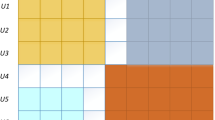Abstract
Recommendation systems have been investigated and implemented in many ways. In particular, in the case of a collaborative filtering system, the most important issue is how to manipulate the personalized recommendation results for better user understandability and satisfaction. A collaborative filtering system predicts items of interest for users based on predictive relationships discovered between each item and others. This paper proposes a categorization for grouping associative items discovered by mining, for the purpose of improving the accuracy and performance of item-based collaborative filtering. It is possible that, if an associative item is required to be simultaneously associated with all other groups in which it occurs, the proposed method can collect associative items into relevant groups. In addition, the proposed method can result in improved predictive performance under circumstances of sparse data and cold-start initiation of collaborative filtering starting from a small number of items. In addition, this method can increase prediction accuracy and scalability because it removes the noise generated by ratings on items of dissimilar content or level of interest. The approach is empirically evaluated by comparison with k-means, average link, and robust, using the MovieLens dataset. The method was found to outperform existing methods significantly.





Similar content being viewed by others
Notes
Grouplens project (http://www.grouplens.org)
Firefly (http://www.firefly.com)
Moviecritic (http://www.moviecritic.com)
Amazon (http://www.amazon.com)
The Internet Movie Database is a good example of a movie recommendation system (http://www.imdb.com)
References
Connor MO, Herlocker J (1999) “Clustering items for collaborative filtering”, Proc. of the ACM SIGIR Workshop on Recommender Systems, Berkeley, CA
Ding C, He X (2004) “K-means clustering via principal component analysis”, Proc. of the 21th Int. Conf. on Machine Learning, pp 225–232
Gose E, Johnsonbaugh R, Jost S (1996) Pattern recognition and image analysis, Prentice Hall
Guha S, Rastogi R, Shim K (2000) “ROCK: a robust clustering algorithm for categorical attributes”, Elsevier Science Ltd., vol. 25, No. 5, pp 345–366
Han EH, Karypis G, Kumar V (1997) “Clustering based on association rule hypergraphs”, Proc. of the SIGMOD’97 Workshop on Research Issues in Data Mining and Knowledge Discovery, pp 9–13
Herlocker JL, Konstan JA, Terveen LG, Riedl JT (2004) Evaluating collaborative filtering recommender systems. J ACM Trans Inform Syst 22(1):5–53
Jalali M, Mustapha N, Sulaiman Md N, Mamat A (2010) WebPUM: a web-based recommendation system to predict user future movements. J Expert Syst Appl 37(Issue 9):6201–6212
Jung KY (2006) “Automatic classification for grouping designs in fashion design recommendation agent system”, LNAI 4251, Springer-Verlag, pp 310–317
Jung KY, Lee JH (2004) User preference mining through hybrid collaborative filtering and content-based filtering in recommendation System. IEICE Trans Inform Syst E87-D(12):2781–2790
Kangas S (2001) “Collaborative filtering and recommendation systems,” Technical Report TTE4-2001-35, VTT Information Technology
Kim TH, Yang SB (2005) An effective recommendation algorithm for clustering-based recommender systems. J Adv Artif Intell 3809:1150–1153
Kim HN, Jia AT, Haa IA, Joa GS (2010) Collaborative filtering based on collaborative tagging for enhancing the quality of recommendation. J Electron Commerce Res Appl 9(1):73–83
Ko SJ, Lee JH (2002) “User preference mining through collaborative filtering and content based filtering in recommender system”, Proc. of the Int. Conference on E-Commerce and Web Technologies, pp 244–253
Li Q, Kim BM (2003) “Clustering approach for hybrid recommender system”, Proc. of the IEEE/WIC International Conference on Web Intelligence, pp 33–38
Michael T (1997) Machine learning, McGraq-Hill, pp 154–200
MovieLens Data Set, http://www.cs.umn.edu/research/GroupLens/, Grouplens Research Project, 2000
Wang J, de Vries AP, Reinders MJT (2006) “A user-item relevance model for log-based collaborative filtering”, Proc. of the European Conference on Information Retrieval, pp 37–48
Acknowledgment
This research was supported by Basic Science Research Program through the National Research Foundation of Korea funded by the Ministry of Education, Science and Technology. (No. 2011–0008934)
Author information
Authors and Affiliations
Corresponding author
Additional information
This paper is significantly revised from an earlier version presented at the International Conference on Information Science and Applications 2011.
Rights and permissions
About this article
Cite this article
Chung, KY., Lee, D. & Kim, K.J. Categorization for grouping associative items using data mining in item-based collaborative filtering. Multimed Tools Appl 71, 889–904 (2014). https://doi.org/10.1007/s11042-011-0885-z
Published:
Issue Date:
DOI: https://doi.org/10.1007/s11042-011-0885-z




